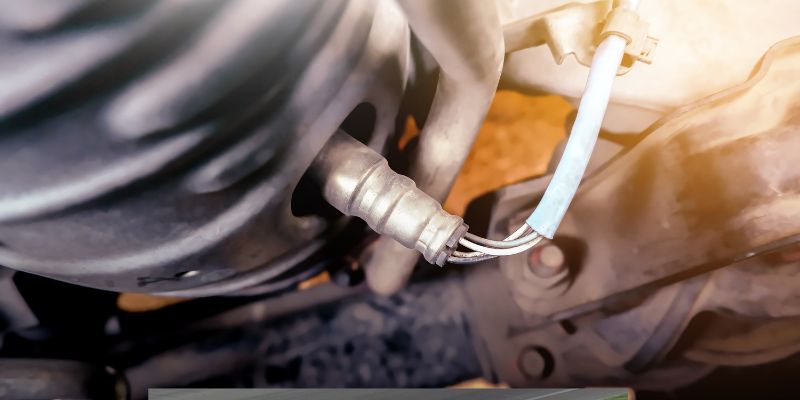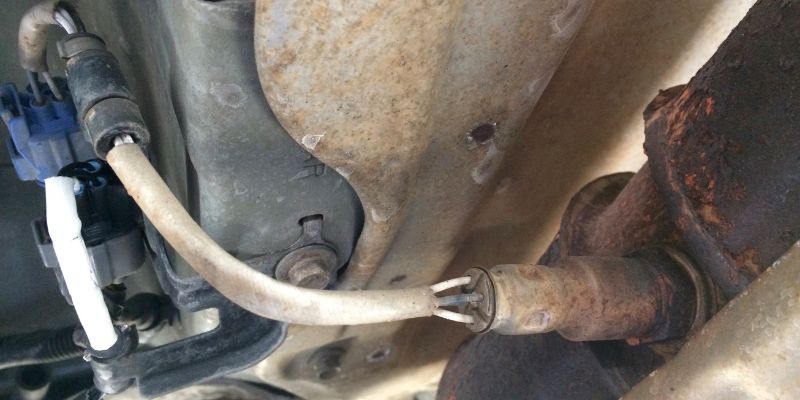How to Bypass O2 Sensor on Ford F150: Ultimate Guide for DIY Modification
To bypass the O2 sensor on a Ford F150, you can install an O2 sensor simulator or use a tuner to disable it. Bypassing the O2 sensor can improve engine performance, but it may not comply with emissions regulations.
If you want to enhance the performance of your Ford F150, bypassing the O2 sensor may be an option for you. However, it’s important to note that doing so may not be legal in some areas due to emissions regulations.
By understanding the potential benefits and consequences, you can make an informed decision about whether bypassing the O2 sensor is the right choice for your Ford F150. Always consider the legal and environmental implications before making any modifications to your vehicle.
Understanding O2 Sensor And Its Role In Ford F150
The O2 (oxygen) sensor in a Ford F150 plays a crucial role in monitoring the air-fuel mixture in the engine exhaust. This sensor helps ensure the vehicle operates efficiently and meets emission standards. Understanding the function and impact of the O2 sensor is essential for any Ford F150 owner or DIY enthusiast.

purpose Of O2 Sensor In Ford F150
The primary purpose of the O2 sensor in a Ford F150 is to measure the amount of oxygen in the exhaust gases. This data is used by the engine control unit (ECU) to adjust the air-fuel ratio for optimal combustion. By continuously monitoring the oxygen levels, the O2 sensor helps the engine achieve peak performance, fuel efficiency, and emission reduction.
impact Of Malfunctioning O2 Sensor On Engine Performance
A malfunctioning O2 sensor can significantly affect the performance of a Ford F150’s engine. It may lead to poor fuel economy, rough idling, and reduced power output. Furthermore, a faulty O2 sensor can trigger the check engine light and cause the vehicle to fail emission tests. Therefore, ensuring the proper functioning of the O2 sensor is vital for maintaining the overall performance and efficiency of the Ford F150.
How To Identify O2 Sensor Issues In Ford F150
When it comes to your Ford F150, one of the crucial components you need to pay attention to is the O2 sensor. Identifying O2 sensor issues in your Ford F150 is essential as it can impact the vehicle’s fuel efficiency and overall performance. Understanding the signs of a faulty O2 sensor and using the right diagnostic tools and techniques is key to ensuring your Ford F150 runs smoothly. Let’s delve into how to identify O2 sensor issues in Ford F150.
Signs Of A Faulty O2 Sensor
Recognizing the signs of a faulty O2 sensor in your Ford F150 can save you from potential performance issues down the road. Some common indicators of a problematic O2 sensor include:
- Poor fuel economy: If you notice that your Ford F150 is consuming more fuel than usual, it could be a sign of a malfunctioning O2 sensor.
- Rough idling: An O2 sensor issue can cause irregular idling or stalling of the engine, indicating a need for inspection.
- Emission problems: A faulty O2 sensor can trigger the check engine light, signaling emission control system issues that need addressing.
Diagnostic Tools And Techniques
Utilizing diagnostic tools and techniques can help pinpoint O2 sensor problems in your Ford F150 with precision. Here are some essential steps to diagnose O2 sensor issues:
- OBD-II Scanner: Use an OBD-II scanner to retrieve error codes and identify the specific O2 sensor causing the problem.
- Visual Inspection: Inspect the wiring and connectors of the O2 sensor for any visible damage or degradation.
- Exhaust Gas Analysis: Conduct an exhaust gas analysis to assess the O2 sensor’s performance and detect potential irregularities.
Legal And Environmental Implications Of Bypassing O2 Sensor
When considering bypassing the O2 sensor on your Ford F150, it’s crucial to understand the legal and environmental implications of such an action. This decision can have far-reaching consequences, impacting not only the performance of your vehicle but also the environment in which we all live. It’s important to be well-informed about the regulations and consequences before making any modifications to your vehicle’s emissions control systems.
Regulations On O2 Sensors In Automotive Vehicles
In the United States and many other countries, regulations mandate that all vehicles must adhere to emissions standards to control air pollution. The O2 sensor plays a crucial role in ensuring that the vehicle’s emissions meet these standards. In fact, modern vehicles are equipped with multiple O2 sensors to monitor and adjust the air/fuel mixture for optimal combustion and reduced emissions. Bypassing or tampering with O2 sensors can lead to violations of these regulations and result in legal repercussions, including fines and penalties.
Environmental Impact Of Bypassing O2 Sensor
Bypassing the O2 sensor can have detrimental effects on the environment. The sensor’s role in the combustion process is to optimize fuel efficiency and reduce harmful emissions. By bypassing this crucial component, the vehicle may produce increased levels of pollutants, contributing to air pollution and environmental degradation. Additionally, inefficient combustion can lead to higher fuel consumption, further exacerbating the environmental impact. It’s imperative to consider the broader environmental implications before making any modifications that compromise emissions control systems.
Preparing For The O2 Sensor Bypass On Ford F150
Necessary Tools And Materials
Before starting the O2 sensor bypass on your Ford F150, ensure that you have the necessary tools and materials on hand. These include:
- Socket wrench set
- Wire cutters
- Screwdriver
- Electrical tape
- New O2 sensor (optional)
Safety Precautions And Best Practices
When performing the O2 sensor bypass on your Ford F150, safety should be a top priority. Be sure to follow these safety precautions and best practices:
- Ensure the engine is cool before beginning any work
- Wear protective gloves and eyewear to prevent injury
- Disconnect the car battery before working on the O2 sensor
- Handle the new O2 sensor with care to avoid damage
Step-by-step Guide To Bypassing O2 Sensor On Ford F150
Are you in a situation where you need to bypass the O2 sensor on your Ford F150? It’s essential to understand the right methods and steps to follow. In this guide, we’ll walk you through the process, providing you with the necessary details to make the task easier for you. Let’s get started with the step-by-step guide to bypassing the O2 sensor on Ford F150.
Locating The O2 Sensors In A Ford F150
Before you can bypass the O2 sensor, you need to know the locations of the sensors in your Ford F150. Typically, the vehicle has two sensors – upstream and downstream. The upstream sensor is usually located before the catalytic converter, while the downstream sensor is positioned after the catalytic converter.
Sewing Or Splicing Method For Bypassing O2 Sensor
The sewing or splicing method involves manipulating the sensor signals to the ECU, tricking it into believing that the sensors are functioning correctly. To achieve this, follow these steps:
- Identify the signal and ground wires of the O2 sensor.
- Using a wiring diagram, determine the color codes of the wires.
- Splice the signal wire and connect it to a suitable resistor to mimic the normal sensor signal.
- Connect the ground wire to complete the circuit.
Welding Method For Bypassing O2 Sensor
The welding method involves bypassing the O2 sensor by essentially removing it from the exhaust system and replacing it with a straight pipe. Here’s how to execute this method:
- Lift the vehicle and secure it safely on jack stands.
- Identify the location of the O2 sensor and the surrounding components.
- Use a cutting tool to remove the sensor from the exhaust system.
- Weld a straight pipe in place of the sensor, ensuring a secure and leak-free connection.
- Lower the vehicle and check for any exhaust leaks before driving.
Testing And Validating The Bypassed O2 Sensor On Ford F150
When bypassing the O2 sensor on your Ford F150, it’s crucial to test and validate the modification to ensure it doesn’t negatively impact your vehicle’s performance or emission compliance. By following these testing and validating procedures, you can ensure that your bypassed O2 sensor is functioning properly.
Checking For Error Codes And Engine Performance
Once the O2 sensor has been bypassed, it’s important to check for error codes and monitor the engine performance to ensure there are no adverse effects. Connect an OBD-II scanner to the vehicle to retrieve any stored error codes. Pay close attention to codes related to fuel mixture, catalytic converter efficiency, and O2 sensor performance. Additionally, monitor the engine’s idle, acceleration, and fuel consumption to detect any irregularities that may result from the bypassed O2 sensor.
Emission Testing And Compliance
After bypassing the O2 sensor, it’s essential to validate the vehicle’s emission levels to ensure compliance with local regulations. Schedule an emission test at a certified testing facility and carefully review the results. Compare the post-bypass emission levels to the baseline measurements taken before the O2 sensor was bypassed. Ensure that the bypassed O2 sensor does not cause an increase in harmful emissions that could result in non-compliance with emissions standards.

Pros And Cons Of Bypassing O2 Sensor On Ford F150
When considering modifications to your Ford F150, it’s important to weigh the pros and cons of bypassing the O2 sensors. While this can potentially improve your vehicle’s performance, it also comes with certain drawbacks and risks. In this section, we’ll delve into the benefits and drawbacks associated with bypassing the O2 sensor on your Ford F150 to help you make an informed decision.
Benefits Of Bypassing O2 Sensor
Improved Engine Performance: Bypassing the O2 sensor on your Ford F150 can result in increased engine performance, as it allows the engine to run in a more optimal state without being restricted by the sensor’s feedback.
Increased Fuel Efficiency: Some Ford F150 owners have reported a slight improvement in fuel efficiency after bypassing the O2 sensor, which can lead to cost savings in the long run.
Custom Tuning Possibilities: By bypassing the O2 sensor, it becomes easier to perform custom tuning on your Ford F150, giving you more control over the vehicle’s performance parameters.
Drawbacks And Risks Associated With Bypassing O2 Sensor
Potential Emissions Violations: Bypassing the O2 sensor can result in increased emissions, which may lead to non-compliance with environmental regulations in some areas.
Risk of Engine Damage: Without the O2 sensor’s feedback, your engine may operate outside of safe parameters, leading to potential damage and reduced lifespan.
Voided Warranties: Bypassing the O2 sensor can void your vehicle’s warranty, leaving you responsible for any related repairs or maintenance costs.
Frequently Asked Questions On How To Bypass O2 Sensor On Ford F150
What Is An O2 Sensor And How Does It Work?
An O2 sensor monitors the amount of unburned oxygen in a vehicle’s exhaust system. It measures the air-fuel ratio to ensure optimal engine performance and lower emissions. When the sensor detects too much or too little oxygen, it sends signals to the engine control unit to adjust the fuel mixture.
Why Would Someone Want To Bypass The O2 Sensor On A Ford F150?
Some drivers may want to bypass the O2 sensor to eliminate check engine light signals caused by faulty sensors or to increase engine performance by allowing the engine to run with a richer fuel mixture. However, bypassing the O2 sensor can negatively impact fuel efficiency and emission levels.
What Are The Potential Risks Of Bypassing The O2 Sensor On A Ford F150?
Bypassing the O2 sensor can lead to decreased fuel efficiency, increased emissions, and potential engine damage due to an overly rich fuel mixture. Additionally, it may result in non-compliance with environmental regulations and could void the vehicle’s warranty. It’s important to consider these risks before bypassing the O2 sensor.
Conclusion
Bypassing the O2 sensor on your Ford F150 can be a complex task, but with the right knowledge and tools, it is achievable. Always remember to comply with local regulations and seek professional advice if necessary. Take the time to research and understand the process thoroughly to avoid any potential issues.








